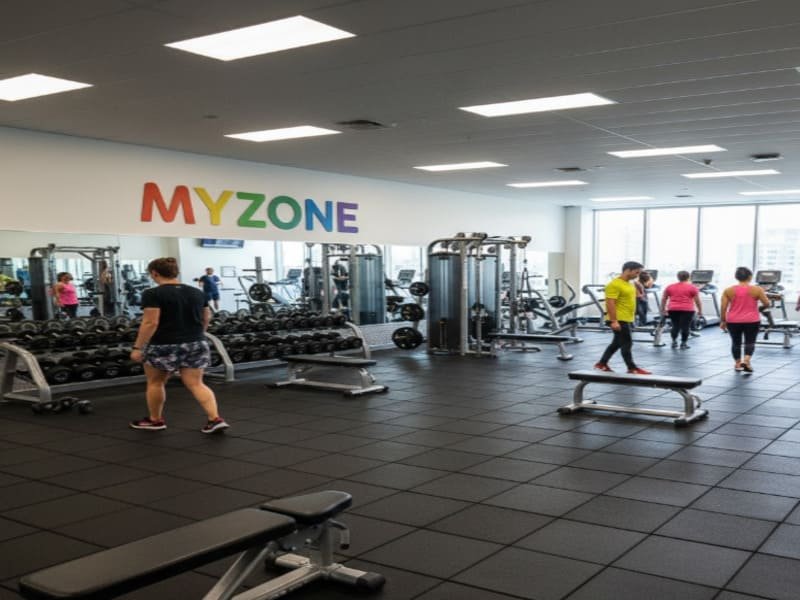Have you ever walked into a gym where the floor looks old, smells bad, or simply does not match the brand? Custom rubber gym flooring protects your investment, enhances athlete safety, and turns your gym into a professional training environment.
I see the results of poor flooring choices every single day. A floor that looks worn down or smells of cheap rubber is not only unattractive; it is a safety risk and a liability. Custom rubber gym flooring solves all these problems. It is not just a material; it is a personalized system designed for specific performance needs, perfect aesthetics, and strong branding. This guide will show you how to select the right material, design the perfect rubber flooring with logo, and understand the cost and installation process. We focus on getting the best blend of durability, safety, and brand impact for your space.
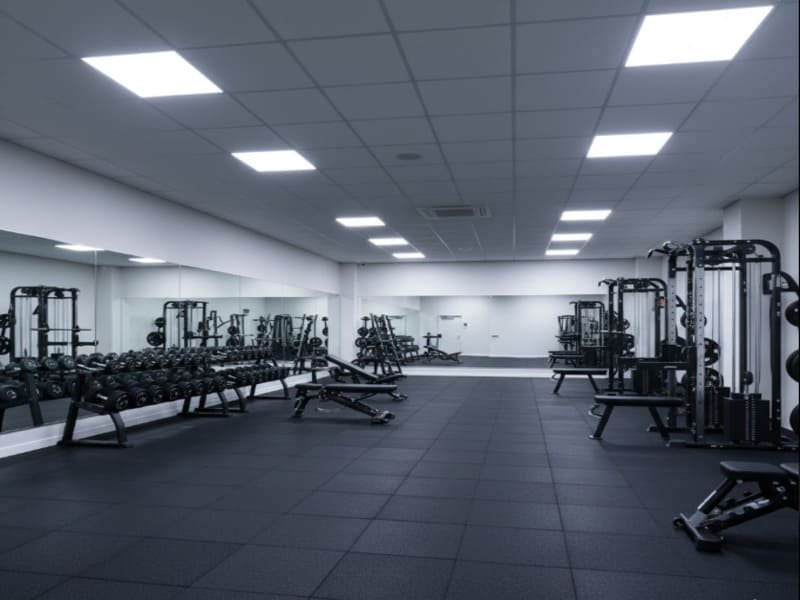
Before you design your floor, you must understand the materials. The material choice sets the stage for performance and cost.
🏋️ How Do EPDM vs SBR Rubber Choices Impact Gym Floor Performance?
The choice between Recycled SBR and Virgin EPDM rubber directly controls the final cost, color vibrancy, odor level, and long-term durability of your floor. This decision must align with the gym’s specific use.
As a QC specialist inspecting raw material batches, I confirm the composition before we start production. This choice is critical. Many clients ask their gym flooring manufacturer for the lowest price, which usually means 100% SBR. This is okay for basic function, but limits design. You need to know how the material types behave:
Recycled Rubber (SBR)
This is the standard workhorse. SBR is highly durable and very cost-effective because it comes from recycled tires. It is often used for custom gym flooring tiles and general weight room areas. The main drawbacks are limited color options—mostly black or dark grey—and a stronger initial off-gassing odor. We use advanced curing processes to minimize the odor, but ventilation is key in the first few weeks after installation.
Virgin/Synthetic Rubber (EPDM)
EPDM is the choice for high-end aesthetics and zero odor. It offers vibrant colors and high UV resistance, making it ideal for studios with natural light or where color matching is critical. Because EPDM is synthetic, it is more expensive. However, it gives you total control for creating branded colors, which is a major advantage for commercial rubber flooring with branding requirements.
Blends (SBR and EPDM)
The most balanced solution is a blend. We use a strong SBR base for structural integrity and cost savings, then mix in colored EPDM flecks for the desired look. By engineering the blend ratio—for example, 80% SBR and 20% EPDM—we achieve a great balance of performance and cost. This allows you to afford a colorful floor without paying the premium for pure EPDM. Always verify the fleck percentage with your gym flooring manufacturer.
| Rubber Type | Primary Benefit | Key Drawback | Typical Use |
|---|---|---|---|
| SBR | High Durability, Low Cost | Limited Color, Possible Initial Odor | General Weight Rooms, Garage Gyms |
| EPDM | Vibrant Color, Low Odor | Higher Material Cost | High-End Studios, Corporate Fitness Centers |
| Blend | Cost/Aesthetic Balance | Fleck Visibility Varies | Commercial Gyms, Functional Zones |
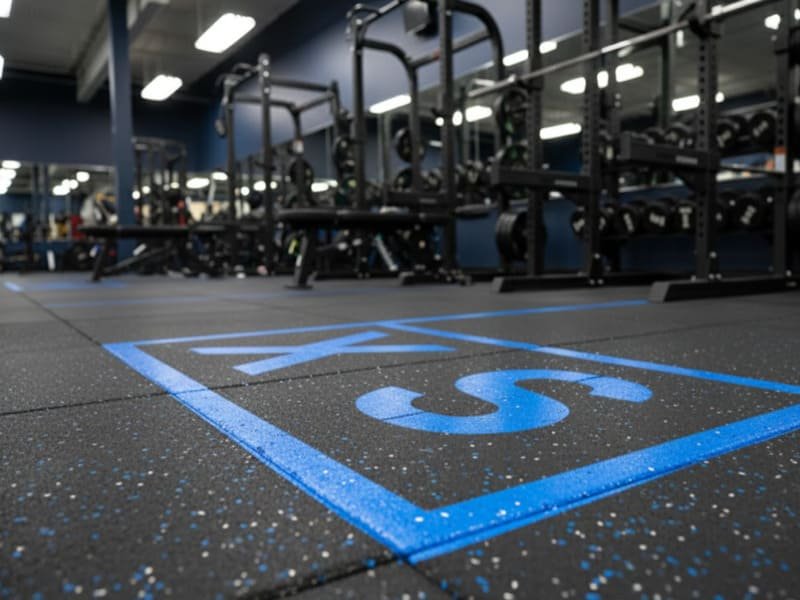
What Thickness Layers Are Needed For Maximum Safety and Subfloor Protection?
Correctly matching the floor thickness and density to the anticipated activity prevents equipment damage and athlete injury. Thickness directly controls the floor’s ability to absorb heavy, repeated impact.
I look at thickness and density together. They are not the same. Thickness determines the cushion. Density, or Shore Hardness, determines the floor’s resistance to permanent indentation. When we talk to a gym flooring supplier, we determine the minimum thickness based on the highest-impact activity.
Thickness Layers Cross-Section
The cross-section of your floor must be engineered for force reduction. Choosing the wrong thickness can void the subfloor warranty.
- 6mm: Suitable for light cardio, stretching, and yoga. It protects the subfloor from wear.
- 8mm – 10mm: The industry standard for general weight training and light functional fitness. 10mm is the most popular choice for custom gym flooring rolls.
- 12mm – 15mm+: Required for heavy powerlifting, Olympic weightlifting, and platform drops. This thickness often includes a shock pad layer to absorb maximum force and minimize vibration transfer.
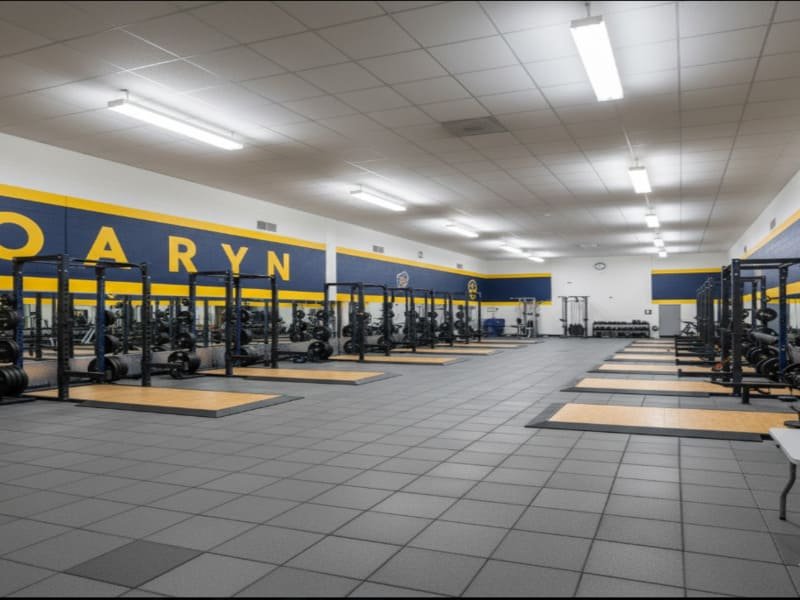
Density (Shore Hardness)
A denser mat (higher Shore Hardness) lasts longer. It resists the permanent deformation caused by heavy static loads, like treadmills or squat racks. Low-density rubber feels softer but wears down faster. We can adjust the density specifically for machine zones to ensure stability and longevity.
How Does Custom Color And Logo Inlay Enhance Brand Identity?
The ‘custom’ factor means your floor is a branding tool. We use precise waterjet cutting and specific color mixing to embed logos and define functional zones, optimizing both look and performance.
When I work with clients on rubber flooring with logo projects, the goal is always perfection. The design must be durable and visually striking.
Custom Color & Mix Ratios
To achieve a perfect brand match, we do not just pick a color; we engineer it. This is done by specifying the exact ratio of EPDM flecks mixed into the SBR base. We can use our Color Innovator tool to show you the digital mock-up before production starts. This approach allows for Value Engineering: by slightly reducing the percentage of the more costly EPDM fleck, we can manage the budget while maintaining the visual integrity of the brand color.
Custom Logos and Inlays
We use waterjet cutting for precision logo work. This technique cuts complex shapes with extreme accuracy, ensuring that the inlaid logo fits flush with the surrounding floor. This is vital for safety and durability, as a raised or uneven logo will wear quickly and become a trip hazard. Logos are typically placed at the gym entrance or within functional zones. I always advise clients to avoid placing complex logos in the highest-impact areas, like deadlift stations, to maximize their lifespan.
Zone and Pattern Creation
We use different colors and textures to create a natural gym floor installation guide for your members. Using a red color for the high-intensity zone and blue for the recovery zone helps manage traffic flow and communicates function immediately. This functionality is built into both custom gym flooring tiles and rolls.
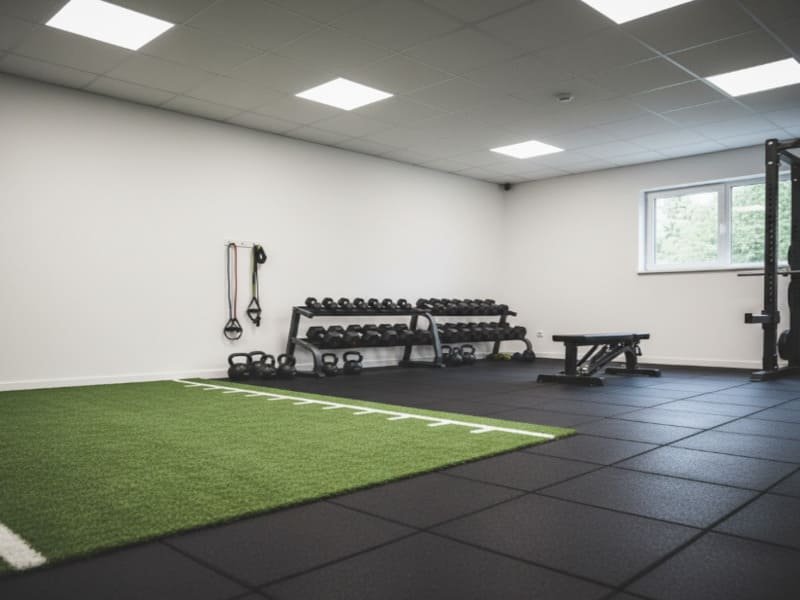
💰 What Are The Typical Price And Lead Time For Custom Gym Flooring?
Cost depends heavily on material, thickness, and EPDM content. Lead times are usually longer for custom colors and logo cutting. Getting a clear quote is the first step.
Cost and timing are practical matters that directly affect your planning. As a gym flooring factory specialist, I can provide general ranges. Remember, these prices are approximate and can change based on volume and global shipping rates.
| Type | Thickness | Application | Approx. Price (FOB China) | Lead Time |
|---|---|---|---|---|
| SBR Tile | 10mm | General Weight Room | $12–$15/m² | 15–20 days |
| EPDM Roll | 6mm | Yoga/Cardio | $10–$13/m² | 20–25 days |
| SBR+EPDM Blend | 10–15mm | Functional Zone/Branding | $14–$18/m² | 25–30 days |
Logistics and Procurement
Lead Time: The time needed to produce the floor usually extends by about 5–10 days for custom color blends and logo cutting due to extra curing and waterjet time.
Minimum Order Quantities (MOQ): For custom colors, the MOQ is usually higher (e.g., 200m²). If you need less, we often guide clients toward our standard EPDM fleck colors to avoid high minimums.
How Does Proper Subfloor Preparation Affect Floor Longevity?
The longevity of your custom rubber floor depends completely on the subfloor. It must be clean, dry, and perfectly level. Any subfloor issue will appear on the surface.
Installation quality is as important as manufacturing quality. I see clients ignore the basics of the gym floor installation guide. This leads to major problems later.
| Pain Point/Worry | Solution/Topic to Cover | QC Specialist Insight |
|---|---|---|
| Odor/Off-Gassing | Use low-VOC/virgin rubber options. Ensure proper ventilation during and after installation. | Virgin EPDM has almost no smell. SBR odor fades faster with powerful air movement. |
| Installation Difficulty | Use interlocking tiles for DIY. Hire a professional for seamless rolls and complex logo inlays. | For custom gym flooring rolls, use only high-quality, manufacturer-recommended adhesives to prevent lifting and shifting. |
| Maintenance & Longevity | Follow simple, neutral cleaner protocols. Check the warranty for wear and color fade. | Never use oil-based or harsh acidic cleaners. These break down the rubber binder, leading to crumbling. |
| Subfloor Issues | The subfloor must be clean, level, and dry. Fix moisture issues and cracks before any installation starts. | The rubber will conform to the subfloor. An uneven floor will cause an uneven and potentially dangerous top surface. |

Conclusion
Custom rubber flooring provides long-term value, superior safety, and a professional brand statement. Engineer the right specs for your performance needs.
Ready to Turn Your Gym Floor Into a Professional, Branded Performance Space?
The right flooring is the foundation of your business. Let my team and me use our manufacturing insight to optimize your design and budget. Contact us today for free design mock-ups, color matching, and sample delivery — we help you build a floor that performs as hard as your athletes.

